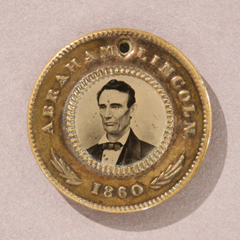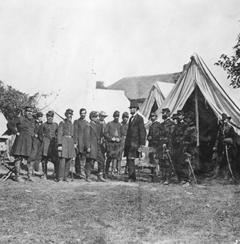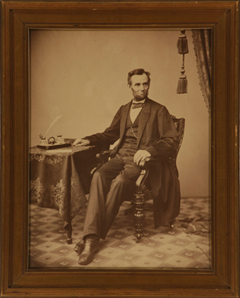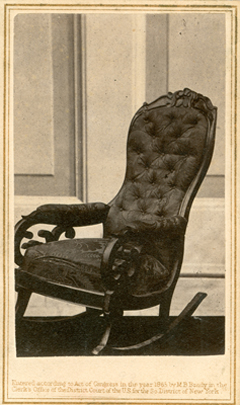| |
The original daguerreotype of this image of Abraham Lincoln was taken by Nicholas H. Shepherd in Springfield, Illinois, shortly after Lincoln’s election in 1846 to the U.S. House of Representatives. It is believed by many to be the earliest known image of Lincoln, who was 37 or 38 years old when it was taken. At this time, Lincoln was a husband and father of two small boys, had a successful law practice in Springfield, and had just become a junior member of Congress.
Daguerreotypes like this one are one-of-a-kind photographs made on silver-coated copper plates. In order to make photographic prints, copy negatives had to be made from the original daguerreotypes. This photographic print was made in the early 20th century from a 19th-century copy negative. In 1902, Frederick Hill Meserve, an early collector of photography, found glass negatives from Mathew Brady’s Washington, D.C., studio in a Hoboken, New Jersey warehouse. Meserve carefully preserved the negatives and made the later photographic prints of the earlier images--including this photographic print in our collection.
 |
This campaign button from the 1860 presidential election shows a tintype photograph of Abraham Lincoln. The image of Lincoln is a copy of an 1858 ambrotype portrait, probably taken by Roderick M. Cole, of Peoria, Illinois. The tintype on the other side of the button shows Hannibal Hamlin, Lincoln’s running mate. This use of photography in political campaigns was still unusual at the time--most campaign buttons did not include photographic images of the candidates.
Lincoln was one of several presidential candidates in 1860, a time when Americans were deeply divided over the issues of states’ rights and slavery. The Republican Party nominated Abraham Lincoln as their presidential candidate. At the Democratic convention, the party could not agree. Northerners turned to Stephen Douglas of Illinois, while southerners selected John C. Breckenridge of Kentucky. There was also a third party choice of John Bell of Tennessee. Throughout most of the South, Lincoln’s name was not even on the ballot! With the vote split among so many candidates, Abraham Lincoln carried all of the eighteen free states to win the 1860 presidential election.
 |
During the Civil War, President Abraham Lincoln often conferred with his military commanders in the field, as this image of an 1862 visit to General George B. McClellan and his officers at Antietam, Maryland, shows. Lincoln – at 6-foot 4-inches and wearing his distinctive top hat – towers over McClellan and his officers. Alexander Gardner took the original photograph on October 3, 1862. This copy print was made in 1926 by the Ford Motor Company Photographic Department in Dearborn, Michigan.
 |
This image of Abraham Lincoln is an early 20th-century photographic print made from an original glass plate negative taken by Alexander Gardner in Washington, D.C., on Sunday, November 8, 1863. Lincoln is shown seated on one of the chairs that was used by the House of Representatives in the 1850s and then replaced and sold as surplus at auction in 1859. Alexander Gardner bought some of these chairs to use in his photographic studio. (Another chair like this one is currently on display in Henry Ford Museum.)
The original glass plate negative was among the large group of Civil War era negatives found and preserved by Frederick Hill Meserve in 1902. For many years, Meserve, who collected thousands of Lincoln photographs, made meticulous prints from original negatives, helping to preserve Abraham Lincoln’s photographic legacy. Meserve made this photographic print from a glass plate negative measuring about 20 x 16 inches. This very large format, called a mammoth plate, captured an incredible amount of detail--even the wrinkles in Lincoln’s boots are clearly visible.
This Lincoln photograph is the curator’s favorite because the details captured truly bring this great man to life.
This sentimental photograph shows President Abraham Lincoln and his youngest son, Tad. Anthony Berger, working for the Mathew Brady Studio, took the original photograph on February 9, 1864. The image was retouched and printed after 1865 by Berger and other photographers, including the unidentified photographer who produced this example. In Berger's alteration, the chair had different details from the chair in the Brady studio.
This popular image of Lincoln and Tad was offered for sale in the form of photographs, lithographs and engravings because of its appealing subject of Abraham Lincoln as a father. In the mid-19th century, small photographs like this one, known as cartes-de-visite, were a popular size to gather into photograph albums similar to the one Lincoln holds in this image. Photographs of famous people like Abraham Lincoln were often purchased and placed in albums along with those of one's family and friends.
 |
This image is of Abraham Lincoln’s catafalque, a temporary structure built to support his coffin during the three days he lay in state in the U. S. Capitol Rotunda in April 1865. Although the original photographer is unknown, we do know that D.C. Burnite of Harrisburg, Pennsylvania, created this small size photographic print called a carte-de-visite. Abraham Lincoln’s assassination on April 14, 1865, plunged Americans into deep mourning. Many people collected mementos like this to help them visualize the events of President Lincoln’s funeral and as a way of expressing the national grief.
This mourning badge was handmade from a small oval tintype portrait of President Abraham Lincoln set into a rope-twist brass frame. The image is surrounded by a black crepe rosette, and decorated with black and white ribbons. This small button, just 2-3/8 inches in diameter, would have been worn during the spring of 1865 to express mourning for the recently assassinated president.
 |
Abraham Lincoln sat in this rocking chair when he was mortally wounded at Ford’s Theatre in Washington, D.C. on the evening of April 14, 1865. Mathew Brady made the original glass plate negative of the chair for his Brady's National Portrait Gallery in Washington. Shortly after, Brady transferred many of his negatives to the photographic supply firm of E. & H. T. Anthony & Company of New York City to pay his debts. Anthony & Co. published this carte-de-visite photograph in 1865. At a time before television and internet news, this photograph helped people visualize events surrounding President Lincoln’s death. (The Lincoln assassination rocker is in the collections of The Henry Ford and is currently on display in Henry Ford Museum.)
| |
-- Cynthia Read Miller,
Curator of Photographs and Prints
|
Where did the Abraham Lincoln photographs in The Henry Fordís collection come from?
While Henry Ford did not have much interest in military or political figures, Abraham Lincoln was the exception. Lincoln, like Ford, was a self-made man and Ford greatly admired his leadership during a difficult time in U.S. history. Henry Ford collected many Lincoln-related artifacts, from the Logan County, Illinois courthouse where Lincoln practiced law in the 1840s to the chair he was sitting in the night of his assassination in 1865. Ford also sought many smaller artifacts to bring this great president’s story alive to inspire schoolchildren and guests visiting Greenfield Village. Photographs that Henry Ford gathered included some 19th-century originals, but also many copy photographs of important images. From the 1920s to the 1940s, Ford had professional and highly skilled photographers in his company’s Photographic Department make many large format and high quality copies of historical originals.
After Henry Ford’s era, museum staff continued to add Abraham Lincoln material, including many photographs. The largest Lincoln-related collection was acquired in 1966 from Thomas Irwin Starr. Starr lived in Michigan and worked for the Michigan Bell Telephone Company as an editor of the employee publication from 1935 to 1954. Fascinated by Lincoln, he built his collection over many years. The material that Starr collected includes letters, documents, books, newspapers, photographs, prints, and ephemera. |
|
|

